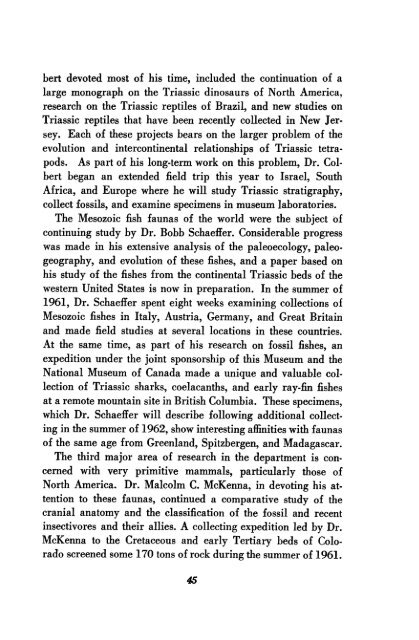1961-1962 - American Museum of Natural History
1961-1962 - American Museum of Natural History
1961-1962 - American Museum of Natural History
You also want an ePaper? Increase the reach of your titles
YUMPU automatically turns print PDFs into web optimized ePapers that Google loves.
ert devoted most <strong>of</strong> his time, included the continuation <strong>of</strong> a<br />
large monograph on the Triassic dinosaurs <strong>of</strong> North America,<br />
research on the Triassic reptiles <strong>of</strong> Brazil, and new studies on<br />
Triassic reptiles that have been recently collected in New Jersey.<br />
Each <strong>of</strong> these projects bears on the larger problem <strong>of</strong> the<br />
evolution and intercontinental relationships <strong>of</strong> Triassic tetrapods.<br />
As part <strong>of</strong> his long-term work on this problem, Dr. Colbert<br />
began an extended field trip this year to Israel, South<br />
Africa, and Europe where he will study Triassic stratigraphy,<br />
collect fossils, and examine specimens in museum laboratories.<br />
The Mesozoic fish faunas <strong>of</strong> the world were the subject <strong>of</strong><br />
continuing study by Dr. Bobb Schaeffer. Considerable progress<br />
was made in his extensive analysis <strong>of</strong> the paleoecology, paleogeography,<br />
and evolution <strong>of</strong> these fishes, and a paper based on<br />
his study <strong>of</strong> the fishes from the continental Triassic beds <strong>of</strong> the<br />
western United States is now in preparation. In the summer <strong>of</strong><br />
<strong>1961</strong>, Dr. Schaeffer spent eight weeks examining collections <strong>of</strong><br />
Mesozoic fishes in Italy, Austria, Germany, and Great Britain<br />
and made field studies at several locations in these countries.<br />
At the same time, as part <strong>of</strong> his research on fossil fishes, an<br />
expedition under the joint sponsorship <strong>of</strong> this <strong>Museum</strong> and the<br />
National <strong>Museum</strong> <strong>of</strong> Canada made a unique and valuable collection<br />
<strong>of</strong> Triassic sharks, coelacanths, and early ray-fin fishes<br />
at a remote mountain site in British Columbia. These specimens,<br />
which Dr. Schaeffer will describe following additional collecting<br />
in the summer <strong>of</strong> <strong>1962</strong>, show interesting affinities with faunas<br />
<strong>of</strong> the same age from Greenland, Spitzbergen, and Madagascar.<br />
The third major area <strong>of</strong> research in the department is concerned<br />
witi very primitive mammals, particularly those <strong>of</strong><br />
North America. Dr. Malcolm C. McKenna, in devoting his attention<br />
to these faunas, continued a comparative study <strong>of</strong> the<br />
cranial anatomy and the classification <strong>of</strong> the fossil and recent<br />
insectivores and their allies. A collecting expedition led by Dr.<br />
McKenna to the Cretaceous and early Tertiary beds <strong>of</strong> Colorado<br />
screened some 170 tons <strong>of</strong> rock during the summer <strong>of</strong> <strong>1961</strong>.<br />
45

















